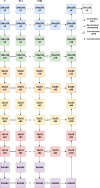This is a preprint.
Recurrent and Concurrent Prediction of Longitudinal Progression of Stargardt Atrophy and Geographic Atrophy
- PMID: 38405807
- PMCID: PMC10888984
- DOI: 10.1101/2024.02.11.24302670
Recurrent and Concurrent Prediction of Longitudinal Progression of Stargardt Atrophy and Geographic Atrophy
Abstract
Stargardt disease and age-related macular degeneration are the leading causes of blindness in the juvenile and geriatric populations, respectively. The formation of atrophic regions of the macula is a hallmark of the end-stages of both diseases. The progression of these diseases is tracked using various imaging modalities, two of the most common being fundus autofluorescence (FAF) imaging and spectral-domain optical coherence tomography (SD-OCT). This study seeks to investigate the use of longitudinal FAF and SD-OCT imaging (month 0, month 6, month 12, and month 18) data for the predictive modelling of future atrophy in Stargardt and geographic atrophy. To achieve such an objective, we develop a set of novel deep convolutional neural networks enhanced with recurrent network units for longitudinal prediction and concurrent learning of ensemble network units (termed ReConNet) which take advantage of improved retinal layer features beyond the mean intensity features. Using FAF images, the neural network presented in this paper achieved mean (± standard deviation, SD) and median Dice coefficients of 0.895 (± 0.086) and 0.922 for Stargardt atrophy, and 0.864 (± 0.113) and 0.893 for geographic atrophy. Using SD-OCT images for Stargardt atrophy, the neural network achieved mean and median Dice coefficients of 0.882 (± 0.101) and 0.906, respectively. When predicting only the interval growth of the atrophic lesions with FAF images, mean (± SD) and median Dice coefficients of 0.557 (± 0.094) and 0.559 were achieved for Stargardt atrophy, and 0.612 (± 0.089) and 0.601 for geographic atrophy. The prediction performance in OCT images is comparably good to that using FAF which opens a new, more efficient, and practical door in the assessment of atrophy progression for clinical trials and retina clinics, beyond widely used FAF. These results are highly encouraging for a high-performance interval growth prediction when more frequent or longer-term longitudinal data are available in our clinics. This is a pressing task for our next step in ongoing research.
Conflict of interest statement
Competing Interests The authors declare no competing interests.
Figures






Similar articles
-
Using Ensemble OCT-Derived Features beyond Intensity Features for Enhanced Stargardt Atrophy Prediction with Deep Learning.Appl Sci (Basel). 2023 Jul 2;13(14):8555. doi: 10.3390/app13148555. Epub 2023 Jul 24. Appl Sci (Basel). 2023. PMID: 39086558 Free PMC article.
-
Segmentation of the geographic atrophy in spectral-domain optical coherence tomography and fundus autofluorescence images.Invest Ophthalmol Vis Sci. 2013 Dec 30;54(13):8375-83. doi: 10.1167/iovs.13-12552. Invest Ophthalmol Vis Sci. 2013. PMID: 24265015
-
[Contribution of multimodal imaging in the various stages of Stargardt disease].J Fr Ophtalmol. 2017 Oct;40(8):666-675. doi: 10.1016/j.jfo.2017.05.008. Epub 2017 Sep 15. J Fr Ophtalmol. 2017. PMID: 28919188 French.
-
Automated segmentation and feature discovery of age-related macular degeneration and Stargardt disease via self-attended neural networks.Sci Rep. 2022 Aug 26;12(1):14565. doi: 10.1038/s41598-022-18785-6. Sci Rep. 2022. PMID: 36028647 Free PMC article.
-
Artificial intelligence for assessment of Stargardt macular atrophy.Neural Regen Res. 2022 Dec;17(12):2632-2636. doi: 10.4103/1673-5374.339477. Neural Regen Res. 2022. PMID: 35662193 Free PMC article. Review.
References
-
- Ma L., Kaufman Y., Zhang J. and Washington I., “C20-D3-vitamin A slows lipofuscin accumulation and electrophysiological retinal degeneration in a mouse model of Stargardt disease”, Journal of Biological Chemistry, vol. 286, no. 10, pp. 7966–7974, 2010. DOI: 10.1074/jbc.m110.178657. - DOI - PMC - PubMed
Publication types
Grants and funding
LinkOut - more resources
Full Text Sources
